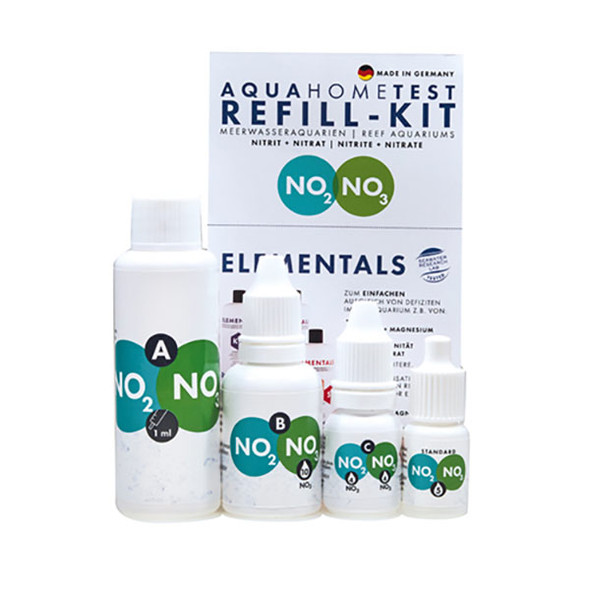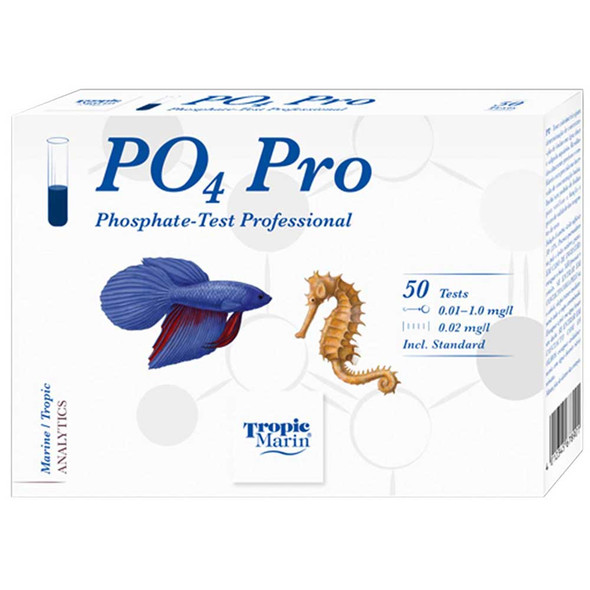Description
Nitrate ions (NO3–) are formed from ammonium (NH4+) as the end product of the nitrification process. Nitrite (NO2–), which is highly toxic to freshwater species in particular, is produced in the first stage of the bacterial process. If the nitrification process works, nitrite is converted to the comparatively non-toxic nitrate in the second stage. Increased levels of nitrite above 0.05 mg/l (ppm) are usually found in tanks that are in their maturation phase or in tanks with nitrate filters.
Nitrate affects the quality of the water in the aquarium: Higher concentrations of nitrate in saltwater aquariums will end up inhibiting the growth of delicate coral. An algal bloom is often the result of a high nitrate level in an aquarium. Some reef aquariums have ultra-low nutrient conditions – nitrate shortages can occur in cases such as these. Therefore, the nitrate concentration in the aquarium water should be tested regularly.
It is advisable to keep the nitrate concentration in freshwater aquariums below 50 mg/l (ppm), whereas the concentration should not exceed 20 mg/l (ppm) in saltwater applications. When nurturing hard coral, the aim is to keep the nitrate concentration below 10 mg/l (ppm). Lower limits for nitrate depend on the general conditions in the aquarium.
- 50 ml/1.69 fl.oz. of reagent A
- 20 ml/0.68 fl.oz. of reagent B
- 10 ml/0.34 fl.oz. of reagent C
- 5 ml/0.17 fl.oz. of reference solution “Standard”
- 1 glass cuvette 20 ml
- 1 dosing syringe 20 ml
- 1 dosing syringe 1 ml with dropper tip
- 2 colour cards
- 1 comparator
- 1 instructions for use
Note: Nitrite concentrations affect the nitrate measurement. Therefore, the nitrite concentration should also be measured and, if required, the nitrate results should be corrected in relation to the table below before carrying out the nitrate measurement. High nitrite levels are usually found in tanks that are in their maturation phase or in tanks with nitrate filters.
High concentrations: If the nitrate concentration is above 20 ppm (if the colours on the colour card are exceeded), dilute 3 ml of the test water with 12 ml of reverse osmosis water and carry outt he test again. The result is then multiplied by 5.
Determining the nitrite level:
- Shake the dropper bottles before use!
- Rinse out the glass cuvette with tap water and then several times with aquarium water.
- Fill the glass cuvette with exactly 15 ml of aquarium water using the dosing syringe and place it in the comparator which serves as a cuvette stand.
- Place the dropper tip on the 1 ml dosing syringe, add 1 ml test reagent A, close the glass cuvette using the stopper, briefly shake the solution and place it back in the comparator.
- Then add 4 drops of test reagent C, close the glass cuvette once again, shake it briefly and place it back in the comparator.
- After 3 minutes of development time, place the glass cuvette in the comparator on the white circles of the nitrite colour card in such a way that the second free opening on the comparator (without cuvette) is underneath the colour card (not on the colour fields) and the narrow end face of the comparator is facing the colour fields. Now the colour of the water sample is compared to the opposing colour fields by daylight conditions. To do this, look into the open cuvette from above. Move the sample on the colour card until the cuvette colour and the colour field colour match exactly.
- Read off the measured nitrite value under the relevant colour field. If the colours do not match exactly, an intermediate value can be estimated.
Determining the nitrate level:
- Shake the dropper bottles before use!
- Rinse out the glass cuvette with tap water and then several times with aquarium water.
- Fill the glass cuvette with exactly 15 ml of aquarium water using the dosing syringe and place it in the comparator which serves as a cuvette stand.
- Place the dropper tip on the 1 ml dosing syringe, draw out 1 ml of test reagent A and add it to the water sample. Close the glass cuvette using the stopper, briefly shake the sample and place it back in the comparator.
- Shake the bottle with test reagent B vigorously in a horizontal direction for approx. 30 seconds (the reagent must be well shaken). Then add 10 drops of test reagent B to the aquarium sample, close the cuvette again, shake it briefly and place it back in the comparator.
- After 3 minutes of development time, add 4 drops of test reagent C, close the glass cuvette once again, shake it briefly and place it back in the comparator.
- After another 3 minutes of development time, place the comparator on the white circles of the nitrate colour card in such a way that the second free opening on the comparator (without cuvette) is underneath the colour card (not on the colour fields) and the narrow end face of the comparator is facing the colour fields. Look into the open cuvette from above and compare it to the opposing colour fields by daylight conditions. Move the sample on the colour card until the cuvette colour and the colour field colour match exactly.
- Read off the measured nitrate value under the relevant colour field. Correct the result if necessary (see table below). If the colours do not match exactly, an intermediate value can be estimated.
- Rinse out the glass cuvette and the syringe thoroughly with tap water after the measurement process.
Using the “standard” to verify the test:
The shelf life of reagents depends on storage conditions and other factors. If the functional capacity of the test is inadequate, there will be no colour reaction during the test, even if nitrate levels are particularly high. If the measurement result is below 1 mg/l (ppm), add five drops of the reference solution “standard” to a new sample in order to verify the reliability of the test. If the colour changes to pink (2 mg/l (ppm)) when you carry out the test again, then the reliability of the reagents is verified as good.
Shelf life and storage: 6 months after opening. Store in a cool, dark place.
Table for correction of nitrate concentration:
* Nitrate concentration cannot be determined because of the high nitrite level






